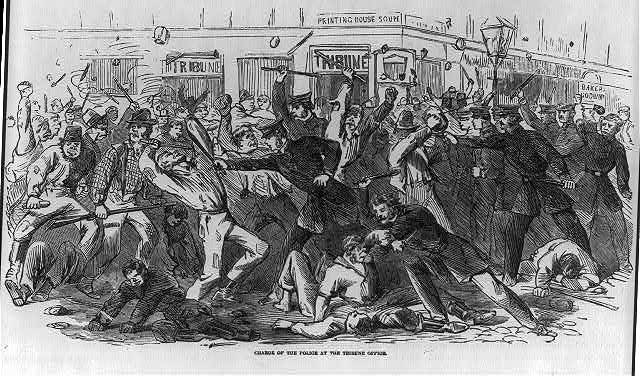By Dr. Jacob K. Friefeld
In March 1864, national tensions boiled over on the streets of Charleston, Illinois, as Union soldiers clashed with attendees of a Democratic rally.
The spring of 1863 through the summer of 1864 was a turbulent time for the Union. The outcome of the Civil War was uncertain. Conscription and enlistment of Black soldiers through the Emancipation Proclamation provided fresh troops even as they inspired discord on the home front and desertions from the army.
Some members of the Northern White working class erupted in violence, angry about the draft and that they were being forced to fight for emancipation. The New York City Draft Riot in July 1863 was particularly deadly. Rioters targeted Black New Yorkers and burned the city’s orphan asylum for Black children. This joined other deadly riots in Hartford, Newark, and Boston as racist and anti-war opposition to federal policies spread.
 “Charge of the Police at the Tribune Office,” a depiction of the New York City Draft Riot in the 1894 Harper’s Pictorial History of the Civil War (Courtesy of the Library of Congress).
“Charge of the Police at the Tribune Office,” a depiction of the New York City Draft Riot in the 1894 Harper’s Pictorial History of the Civil War (Courtesy of the Library of Congress).
Though it faced nothing on the scale of the New York riot, Illinois didn’t escape the tumult. On March 6 and 7, 1863, Union sergeants Thomas Long and John McFarland crossed from Indiana into Illinois with a small force and arrested five deserters from the army. On the morning of March 8, the Clark County Sheriff placed the two sergeants under arrest for kidnapping the deserters.
The sergeants appeared for a hearing before Judge Charles H. Constable. Constable didn’t allow Long and McFarland to prove that the men they arrested were, in fact, deserters because he claimed that Union military officers in Indiana had no right to arrest deserters in Illinois. He set a court date for the following week for Long and McFarland to answer the charge of kidnapping.
News of the arrests reached General Horatio Wright in Indiana who had grown concerned by increasing anti-government sentiment in Southern Illinois opposing the Emancipation Proclamation and the draft. Wright sent Colonel Henry Carrington to investigate. On the day of the trial, while the court was convened, Long and McFarland got up from their seats and joined four army troopers who had entered the courthouse in civilian clothes. As the sheriff ordered them back to their seats, Carrington rose and informed Constable that over 200 Union soldiers surrounded the courthouse. Constable adjourned the court and Carrington placed him under arrest for usurping the military’s authority.
 General Horatio Wright as photographed by Mathew Brady during the Civil War (Courtesy of the National Archives and Records Administration)
General Horatio Wright as photographed by Mathew Brady during the Civil War (Courtesy of the National Archives and Records Administration)
Constable’s arrest set off a month-long debate over whether a military tribunal or civilian court should try the judge. Some thought the military had overstepped its authority, though, as historian Stephen Towne points out, the arrest received the Lincoln administration’s full support. Constable’s case was eventually handed to a civilian court and promptly dismissed.
The Constable affair only served to increase animosity between Union soldiers and Copperheads in Southern Illinois. In January 1864, Constable was accosted on the streets of Mattoon by members of the 54th Illinois Infantry stationed in the town. They forced Constable to pledge his allegiance to the federal government — forcing Copperheads into oaths of allegiance to the Lincoln administration was a common pastime for drunk soldiers on the streets of Mattoon. In nearby Charleston, tensions only increased when soldiers of the 54th attacked and beat two Democrats.
 James Thomas, a member of the 54th Illinois Infantry stationed in Mattoon in 1864 (Abraham Lincoln Presidential Library and Museum)
James Thomas, a member of the 54th Illinois Infantry stationed in Mattoon in 1864 (Abraham Lincoln Presidential Library and Museum)
On March 28, 1864, tensions led to open battle as members of the 54th passed through Charleston during a Democratic rally. Both the crowd at the rally and the soldiers in town had been drinking. Sometime after 3:00 PM, local Democrat Nelson Wells fired at Private Oliver Sallee. It’s unclear if that bullet or another one fired in the confusion killed Sallee, but before he died, Sallee returned fire and killed Wells. Six soldiers and three civilians lay dead with another twelve wounded before 250 Union troops arrived from Mattoon to put an end to the fiasco.
Neither those rioting in the northeast nor Illinoisans battling on the streets of Charleston knew if the following year would see the inauguration of Lincoln or Democrat George McClellan. The violence in cities across the nation reminded Americans of the deep divisions that existed in the Union. In particular, opposition to emancipation reminded Black Americans that though they may be free, their nation was still far from delivering equality.
Also this month in Illinois History…
- March 2, 1868: The Illinois Industrial University, now known as the University of Illinois at Urbana-Champaign, opened.
- March 9, 1832: Abraham Lincoln wrote a campaign platform to support his candidacy for the Illinois House of Representatives.
- March 12, 1902: Governor John Peter Altgeld died in Joliet. He is most remembered for pardoning the surviving three men convicted for the Haymarket Affair.
- March 28, 1990: Jesse Owens was posthumously awarded the Congressional Gold Medal. After winning four gold medals at the 1936 Olympics in Berlin, Owens had moved to Chicago and eventually became director of the Chicago Boys Club.
Friefeld is an ALPLM research historian specializing in the history of Illinois and the Midwest.